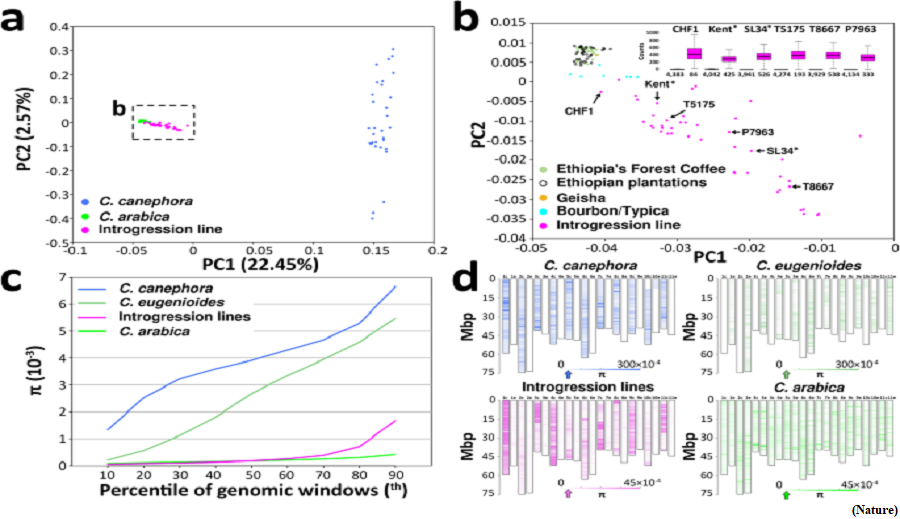Chromosome study reveals low genetic diversity of Arabica coffee (GS Paper 3, Science and Technology)

Why in news?
- Based on a chromosome-level assembly, a study reveals the sources of genetic diversity of Arabica coffee; the genetic diversity may contribute to its unique flavour and resistance to pathogens.
- About 60% of global coffee production is from the Arabica coffee species.
Arabica coffee:
- Commercial coffee is mainly produced from Coffea canephora and Coffea arabica, known as Robusta and Arabica coffee, respectively.
- Arabica coffee is derived from the hybridisation between the ancestors of present-day Robusta coffee and another closely related coffee species, Coffea eugeniodes.
- This hybridisation resulted in Arabica’s coffee flavour and its large and complex genome, which poses challenges for breeding and genetic studies. Several partial genome assemblies of Arabica coffee are currently available, but the mechanisms generating its genetic diversity are unclear.
Recent research:
- Researchers from the Istituto di Genomica Applicata, Udine, Italy, and others employed the latest sequencing technologies to generate a more complete genome assembly for Arabica coffee, allowing for a detailed analysis of the structure of its chromosomes.
- When analysing the genome, including previously inaccessible regions, such as those around centromeres, they found differences in the structure, function and evolution of the genomes contributed by its two progenitor species, especially for genes involved in caffeine biosynthesis.
- They also analysed the genomes of 174 samples collected from different species within the Coffea genus and noticed a very low level of genetic diversity within Arabica coffee.
Timor Hybrid:
- Diversity was found to increase in some Arabica coffee cultivars at specific genomic regions, due to two different sources of variation: chromosomal abnormalities and genetic segments donated by a Robusta-Arabica hybrid, known as the Timor Hybrid.
- This hybrid has become the parental line of many modern cultivars that combine the disease resistance trait of Robusta coffee and the unique flavour of Arabica coffee.
Way Forward:
- They suggest that the genetic diversity of Arabica coffee is essential for its commercial success, and the findings may help develop new coffee varieties with desirable traits, such as disease resistance or different flavour profiles.
Western Equine Encephalitis outbreak in Argentina
(GS Paper 2, Health)
Why in news?
- Recently, the International Health Regulations National Focal Point (IHR NFP) in Argentina alerted the Pan American Health Organization/World Health Organization (PAHO/WHO) of a human case of Western Equine Encephalitis Virus (WEEV) infection.

Background:
- The last cases of human infections in Argentina were reported in 1982, 1983, and an isolated event in 1996. The present outbreak also comes in the context of an ongoing outbreak in horses in Argentina and Uruguay.
- Multiple outbreaks and human cases of Westen Equine Encephalitis have been reported in the past from the U.S. and Canada and over 3,000 cases of infection have been reported over these years.
Transmission of Western Equine Encephalitis:
- Western Equine Encephalitis is a mosquito-borne infection caused by the WEEV, which belongs to the Togaviridae family of viruses.
- The virus has an approximately 11.5 kilobases long single-stranded RNA genome and is a recombinant of the eastern equine encephalitis virus and a Sindbis-like virus.
- Passerine birds are thought to be the reservoir and equine species as intermediate hosts. The primary mode of transmission of the infection to humans is through mosquitoes which act as vectors for the virus. While most of the infections are asymptomatic, the infection may lead to severe consequences in rare cases.
- An estimated 4-5% of cases may manifest as infection/inflammation of the brain, resulting in neurological symptoms and sequelae of disease. With no specific antiviral treatment, symptomatic care is crucial, especially for neurologic symptoms.
Way Forward:
- While PAHO/WHO has issued an alert on the risk of the spread of WEEV in the Americas, enhanced surveillance and detection of infections will be crucial for preventing the spread of the virus.
- Following a One Health approach is essential for the control of the virus.
- Environmental modifications, vector control, and vaccination for equines in affected and high-risk regions to curb the potential spread of the virus.



